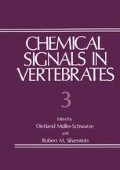Abstract
Infant rats prefer the odors from lactating females to those from males, non-lactating females or non-odorized stimuli (Leon, 1974; Brown, 1978). There are strain differences and dietary factors in these odor preferences. Long-Evans hooded rat pups show a greater attraction to the odors of non-lactating females than do albino pups (Galef and Muskus, 1979),and pups prefer the odors of lactating females eating the same diet as their own dam to the odors of females on another diet (Leon, 1975; Galef, 1981).
Access this chapter
Tax calculation will be finalised at checkout
Purchases are for personal use only
Preview
Unable to display preview. Download preview PDF.
References
Brown, R.E. 1978. Rearing environment and the generalization of odor preferences in infant rats. Paper presented at the third ECRO Congress, Pavia, Italy.
Galef, B.G., Jr. 1981. Preference for natural odors in rat pups: Implications of a failure to replicate. Physiol. Behay., 26: 783–786.
Galef, B.G., Jr., and Muskus, P.A. 1979. Olfactory mediation of mother-young contact in Long-Evans rats. J. Comp. Physiol. Psychol., 93: 708–716.
Lee, T.M., and Moltz, H. 1980. How rat young govern the release of a maternal pheromone. Physiol. Behay., 29: 983–989.
Leidahl, L.C., and Moltz, H. Emission of the maternal pheromone in the nulliparous female and failure of emission in the adult male. Physiol. Behay., 14: 421–424.
Leon, M. 1974. Maternal pheromone. Physiol. Behay., 13:441–453. Leon, M. 1975. Dietary control of maternal pheromone in the lactating rat. Physiol. Behay., 14: 311–319.
Leon, M. 1978. Emission of maternal pheromone. Science, 201: 938–939.
Moltz, H., and Lee, T.M. 1981. The maternal pheromone of the rat: Identity and functional significance. Physiol. Behay., 25: 301–306.
Moltz, H., and Leidahl, L.C. 1977. Bile, prolactin, and the maternal pheromone. Science, 196: 81–83.
Author information
Authors and Affiliations
Editor information
Editors and Affiliations
Rights and permissions
Copyright information
© 1983 Springer Science+Business Media New York
About this chapter
Cite this chapter
Brown, R.E. (1983). Odor Preferences of Young Rats: Production of an Attractive Odor by Males. In: Müller-Schwarze, D., Silverstein, R.M. (eds) Chemical Signals in Vertebrates 3. Springer, Boston, MA. https://doi.org/10.1007/978-1-4757-9652-0_24
Download citation
DOI: https://doi.org/10.1007/978-1-4757-9652-0_24
Publisher Name: Springer, Boston, MA
Print ISBN: 978-1-4757-9654-4
Online ISBN: 978-1-4757-9652-0
eBook Packages: Springer Book Archive

